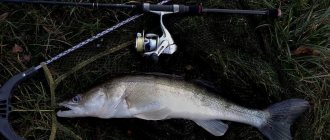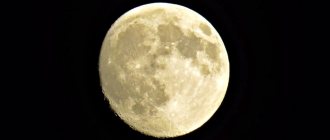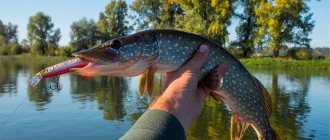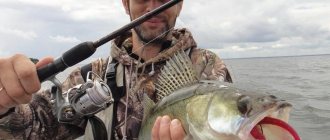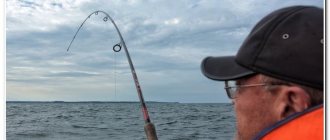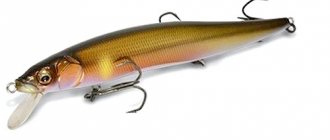Yuri 03.11.2020 177
The time of day directly affects the life activity of fish. The more comfortable the indicators (water temperature, oxygen level, activity of food objects), the more confident the representatives of the aquatic fauna feel. Let's talk about night fishing and active fish after sunset.
Fishing at night
Fishing at night
Most fishermen are of the opinion that the best time for summer fishing with a float rod is morning and evening dawn. However, as the experience of some of them shows, night fishing is no worse, and sometimes more productive and gives results that one can only dream of during daylight hours.
At night the bite is more active, practically nothing bothers you. The explanation for this is the daily migration of white fish, which approaches the shore at night and moves away from it at dawn.
The coastal zone is more dangerous for it during the day, since there are more shelters in which a predator can hide. The return of fish to the shore at night is due to a feeling of hunger. The food here is smaller, there is more food, it is more varied. And the likelihood of a predator attack is less.
The advantage of night fishing is practically solitude on the shore. No one annoys or interferes with their advice or conversations. In addition, the weather becomes calmer, the wind subsides, and the breaking waves cease to drive. The temperature drops, not only humans but also fish feel more comfortable, which affects their appetite and biting intensity.
The main disadvantage of night fishing is poor visibility. Therefore, when going to a reservoir, you need to take a supply of gear with you. It’s difficult to unravel or repair something in the dark, so it’s easier to change it. Don't forget about warm clothes - at night, despite the summer weather, it can get noticeably colder. A fire is no help when using float gear.
What are the benefits of fishing at night?
- at night there is a high probability of catching a large fish, which hunts for every little thing at such a time;
- small fish are not bothered by false bites, since at night they group near the shore;
- at this time of day the reservoirs become calm, it becomes cooler, and the fish feel much more comfortable;
- At night the air temperature is more comfortable.
There are not many disadvantages to this fishing, but they do exist:
- low visibility, so you should take a light source with you (preferably more than one);
- As it gets colder, you should take a set of warm clothes with you.
Fish that are caught at night
With the onset of darkness, pike perch, ide and other predators go out to shallow riffles, where they actively hunt for small fish. The most attractive are rocky rifts with pronounced jets (it is desirable that the jets go along or from the shore). Moreover, out of three seemingly identical places, one will work regularly, another occasionally, and in the third it is almost impossible to see a bite. Finding a good place is not easy, but with 5-6 catchable spots in stock, you can successfully fish all night.
Also, during the twilight period, bream, crucian carp, burbot, large pike, and record-breaking specimens of carp are readily caught on the fisherman’s bait. These abodes of a reservoir can be located both at depth and near the shore. The true owner of shallow waters is considered to be pike perch. Fans of night fishing can seriously count on catching it, so they often organize targeted fishing with a selection of gear and bait. If during the daytime pike perch prefers to stay in the depths, then at night, when the water is warmed by the summer sun, it goes out into shallow water. An experienced fisherman distinguishes the approach of pike perch by its characteristic splashes. They resemble a perch approaching the shore, as if the fish were moving in waves, but there was no slurping sound. Almost all aquatic lovers of night feeding bite at sunset, then calm down for a while, and at midnight they again have a feast, which plays into the hands of lovers of night fishing.
Choosing a place to fish at night
As already mentioned, at night the reservoirs are quite dark, so it is better to choose places convenient for fishing in the daytime. They need to be cleared of all rubbish and equipped with convenient approaches. As a rule, fish group at night in places with a quiet current, near shallows, on the edge.

On hot summer nights, fish come out in search of food, so the bite at this time can be very good, but not constant. That is why in the evening it is worth actively feeding the fishing spot by throwing dense and viscous bait balls into the water. By the way, don’t forget about this during the fishing process.
Gear for fishing at night
Firefly for fishing Often, anglers choose a fly rod with a blind fastening of the equipment, rather than light bottom tackle, because, as a rule, you fish at night in the same place as during the day.
The place has already been well explored and fed. You can expect with a certain degree of confidence that a large fish will come to the feeding point. For night fishing you only need to change the equipment. Tying it right on the shore is a five-minute task. The equipment is made taking into account the fishing conditions in a given place, the strength of the current and the size of the possible trophy. Appropriate main line and sinker are used. An almost universal option - a main line with a diameter of 0.15-0.18 mm and a sinker weighing 20-30 g; for a very strong current, you can use a sinker up to 40 g; I have not had to use heavier ones.
The equipment itself is simple and at the same time universal. Its length is 40-60 cm less than the length of the rod, and with a leash it will be 10-30 cm shorter than the fishing rod. This length is most convenient: when pulling out the tackle, there is no need to try to catch a too long or short tackle in the dark, it falls right into the hand. For this kind of fishing, I use a rod no shorter than 7 m, usually 8-10 m. But this does not mean that you cannot fish in this way with a short rod, 5-6 m long; this is determined only by fishing conditions and the availability of suitable gear. Not being a big supporter of rigid rods, I still have to note that for this type of fishing a rigid rod is more suitable for two reasons.
Firstly, working with fairly heavy weights (and for a fly rod 20-30 g is a lot) requires decent power, and secondly, the bite through a rigid rod is transmitted much more clearly, which eliminates the need to monitor the tip. You can’t discount the possibility of biting a large fish, which is still better to fish with a rod that has a power reserve. To the greatest extent, all these requirements are met by a rod equipped with a rubber shock absorber, which provides a large reserve of power and strength of the tackle when fighting large fish. At the same time, the rubber shock absorber does not interfere with fishing and does not change the sensitivity of the gear.
An additional element is the attached firefly on the tip of the rod, but, as practice has shown, it is quite possible to do without it. The firefly is attached to the tip of the rod with two silicone rings from the kit. First of all, it serves as a reference point for the position of the rod, which means the location of the gear at the bottom. It is not necessary to detect a bite on a firefly - it is perfectly transmitted to the hand. Perhaps only weak, uncertain bites can be additionally tracked by the movements of the firefly.
Based on what has been said, it follows that straining your eyes, trying to see a luminous point 10-15 m from the shore, as with ordinary float gear, is absolutely useless. You can admire the surrounding nature, look at the stars, watch the most interesting night life of the river, in general, enjoy the “float meditation” to the fullest. And all the actions performed with the nozzle at the bottom will be transmitted to the hand through the rod.
The obvious advantage of such fishing, on the one hand, is that there are practically no bites of small fish, but on the other hand, bites, as a rule, are few and the value of each successfully realized one increases many times over. This means you need to be on your guard.
A necessary element of equipment is a reliable stand, installed so that the lower part of the rod outweighs the upper, then there is no need to hold the rod with your hand when fishing and feeding. When installing the stand, I try to ensure that the rod whip is located 5-10 cm from the water. For such a stand I use an aluminum ski pole, at the top of which there is a reliable double W-shaped stop made of thick aluminum wire (5-7 mm in diameter), covered with cambric. The butt of the fishing rod simply rests on the box. The two locations of the rod on the stand roughly determine the location of the tackle on the bottom; a more precise location depends on the location of the butt of the rod on the box.
What to use to catch crucian carp at night
When choosing bait, you should take into account the fishing season, which is mainly summer. In summer, crucian carp responds well to bait of both plant and animal origin. And of course, it is worth considering the size of the crucian carp. For larger ones, larger baits like peas, corn, a bunch of dung worms, crawlies, etc. are better suited. For smaller crucian carp, a single dung worm, pearl barley, bloodworm, maggot, etc. are suitable.
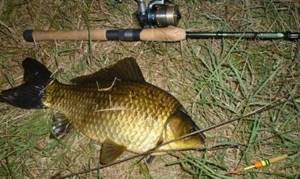
To catch crucian carp at night, choose the following baits:
- muckworm;
- crawl out;
- bloodworm;
- maggot;
- peas;
- corn;
- pearl barley;
- dough;
- semolina.
In addition, you must take into account the gear you are fishing with. After all, when fishing on a feeder, such a bait as dough will be ineffective, because the likelihood that it will simply fall off the hook in flight when casting or directly when hitting the water is very high. But a worm, corn or peas are perfect for both a feeder and a float.
By the way, it has been noticed that on a float rod, at a short distance from the shore, more bites occur with smaller baits, such as a worm, maggot, pearl barley, etc. If, for example, you place corn on the feeder and a float rod at the same time, then more bites usually occur on the feeder. But the number of bites on a worm may be greater on a float rod.
In September, when the water begins to cool, place more emphasis on bait of animal origin, since from this time the crucian carp gradually begins to switch to protein foods and gradually switches exclusively to food of animal origin.
Bait for fishing at night
You can use any bait for night fishing, including steamed barley grains, semolina, bread pellets, grasshoppers, and flies. But it is better to keep the fish in one place near the edge of underwater vegetation for two to three hours using bait with a small content of breadcrumbs, large maggots and small earthworms mixed into balls of clay and earth. In the dark, fish respond better to bait that is not only tasty, but also aromatic. Moreover, the aroma can be created not so much with the help of artificial additives, but with the help of “natural products”. To do this, several worms and larvae should be crushed, then a strong, persistent smell will emanate from them far around. It is not advisable to overfeed heavily at night, since the fish actively moves, and the fisherman follows it.
Light in the hole or artificial illumination of bait when winter fishing at night at depth
A lot of devices and underwater “lights” were offered. The essence of the method is to lure fish. It is based on the natural “love” of the underwater inhabitant and his curiosity about the light source located at the bottom and beckoning under the darkness of the ice. The night bream, which is distinguished by both caution and curiosity at the same time, especially suffered from underwater “lanterns”.
The meaning of “highlighting” is to lower a burning light bulb to the bottom through the hole, which should lure the fish from afar to the baited place and, accordingly, to the jig. Coming to light, the same bream will find a “yummy” on the hook and will inevitably bite.
The most, how to put it, optimal, we thought was a “device” consisting of a light bulb or LED with a battery and a sealed test tube. Of course, this was true in those ancient times, when there was tension in the country with Chinese or just small lanterns.
We, in the absence of a test tube, and the reluctance to look for one, “fiddled around” a little with a small LED flashlight, fortunately, China put a lot of different ones on our market. First, we achieve tightness. It's easy to do.
The simplest way is to wrap the flashlight in several layers of sausage film. Well, you know, the thin plastic one, the kind they use to package sausages or cheese in stores. It “sticks” well and does not let water in.
It was a little more difficult to silicone the loosening parts with the appropriate sealant. Next, we tie the “light bulb” to the fishing line, weigh it down if necessary, and now the flashlight is ready to “immerse” in the hole. At a depth of up to 5 m, if you bend down to the hole, you can even “steer” the light in the right direction, i.e. on the jig.
The only inconvenience for the ice fisherman is the presence in the hole of both the fishing line from the flashlight and the fishing line of the rod. Therefore, in order to avoid “hooks” when fishing, we drill a couple of holes - we catch in one, and “drown” the lantern in the other. Cheap and easy. You can even drill three holes, two of which will be “working” and one will be illuminated.
By the way, when fishing for bream at night in “still” water, the illumination method is very effective. Since the night in winter fishing is somewhere from 18 o’clock in our area, the “light” attracted roach, crucian carp and bream until 22. Then, only bream and bream “run up” to the light.
The rigs used were silver and purple jigs with contrasting bait. Phosphorescent jigs, or even their tandem with regular jigs, are also good. So, we liked the work of a pair of jigs on the bream - phosphorus on top, silver on the bottom.
Here, a silver jig with maggots lay on the bottom in the light of a flashlight, while the phosphorus “hovered” 15-20 cm above it. However, you can try tandems in a different ratio of baits, selecting the most “fruitful” one for the fish.
Farit Gizatulin - Especially for the site Homemade products for fishing, Serov, Sverdlovsk region, Russia. Photo: Garinskiy(E1.ru)
- Methods for attaching a winter tent on ice
- Insulation and wind protection of a single-layer umbrella tent
Equipment and equipment
There are two things that we do not need during the day, but which are in great demand at night. This is warmth and light.
Cloth
In the temperate zone, even in summer the nights can be cool. Only a sudden warm atmospheric front, or a prolonged abnormal heat wave that lasted at least two to three weeks, can give us several warm nights. But more often it happens that the thermometer, which stormed the 40-degree mark during the day, drops below ten degrees in the morning.
The coolness of the night is felt especially strongly near bodies of water - in a humid atmosphere. The dew that falls abundantly on the banks only contributes to this.
From here we can draw the only conclusion - if you are planning to fish at night, even if the weather forecast is favorable, you should take an “autumn” set of clothes with you, just in case. An option is a knitted hat, sweater or insulated jacket; you can also throw extra pants in your backpack. I know fishermen who take “fofans”, “vatniks” and other padded jackets, suitable not only for the off-season, but also for winter. And I know cases when all this came in handy, for example, during sudden bad weather.
Even if you don’t need to put everything on at night, during the day additional clothing will act as a pillow when the fisherman sleeps off after fishing.
Tent
Another help in keeping warm while fishing at night. This is especially true in cold weather. The tent is also good because it can accommodate a heater or one of those heat sources that are described in detail here.
The only drawback of the tent is the inability to visually and tactilely control the gear. Therefore, its use is justified only in the case when night fishing is carried out on donks with an audible alarm.
Bonfire
If during night fishing you do not intend to change the place of fishing, then lighting a fire next to it will make the process more comfortable. The only thing you need is to correctly position the fire pit.
The best place for it is to the side and slightly behind the fisherman. Such that you can warm up and periodically watch out of the corner of your eye. The “power” of the fire is set to the necessary minimum, because if it blazes “like a pioneer”, it will not only unnecessarily illuminate a good part of the fishing area and scare away some fish, but can also damage the tackle, especially the fishing line if we are fishing with a float rod or a boat. However, even with a moderate fire, there should be a small space between the seat and the water’s edge - enough for you to stand up, take a step or two and, with complete safety for the fishing line, re-cast the tackle or bring out the fish.
Lighting
At first glance, it seems that everything is simple with lighting - a more powerful flashlight, and preferably with a hanging function. But in reality, the light is not suitable for night fishing. It must meet two requirements:
- Be strong enough so that the fisherman can manipulate bait without straining his eyesight.
- Be moderate enough so as not to illuminate the fishing area, so as not to create unnecessary glare near it.
Mutually exclusive points, aren't they? It is between them that we need to find a middle ground.
The best option is two flashlights. One is a low-power head-mounted one (for example, with five LEDs), the second is a long-range manual one. The first one is enough to replant, and besides, it won’t scare the fish again, since it simply won’t reach it. The second one is needed in case you suddenly need to look at what is happening on the distant approaches to the fishing point.
Recommendations for night fishing enthusiasts
At night it is better to fish from the coastal zone, as it is safe and convenient. In addition, at this time of day there are few fishermen on the reservoirs, so you can set up a fishing spot in comfort without fear of disturbing anyone. It is better to fish with a spinning rod by wading, standing in knee-deep water. It is not advisable to fish on a boat at night, as it is simply dangerous. If you still decide to do this, then you should equip the craft with side lights and warning beacons.
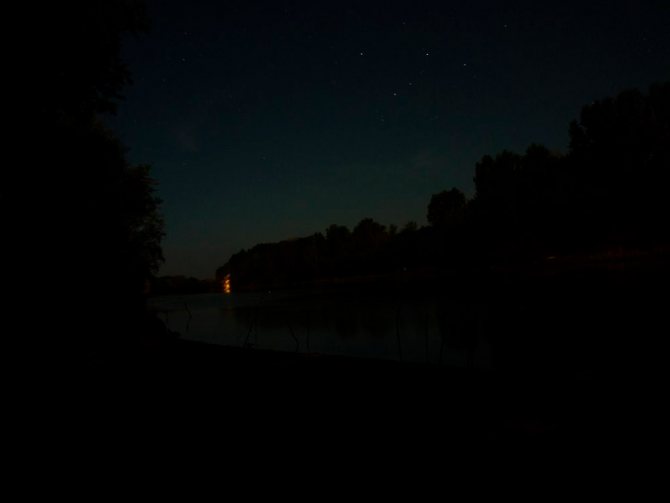
This picture can be seen if problems arise with the flashlight 

Donks need to be securely fastened to the shore so that trophy fish cannot drag them into the water. If you fish with several feeders, then place them at a distance from each other so that the gear does not accidentally get tangled.
Thank you for fishing with us! Or not yet? Yandex.Zen Facebook
Tags:
night fishing tips
Adviсe
Everything you need for night fishing should be at hand. The box with baits is placed in a pocket or attached to a stand stuck into the ground near the fishing spot. The extractor is hung around the neck.
It is necessary to have a supply of nozzles. A certain amount of it should be stored somewhere in a certain place, for example, in a backpack. The most convenient attachment is considered to be maggot, which is attached in a bunch. It is not often swallowed by fish, and it has to be changed less often. The advantage of maggots is that they can be easily threaded on a hook in the dark.
In order not to break or damage the tackle, it should be placed on the stand every time you get up from the chair or rest. When planning to go night fishing, it is worth preparing several equipment and a supply of leashes.
To increase sensitivity, the float when fishing at night is placed under the antenna itself. Equipping it with a luminous nozzle is done in two ways: from the side, using nipple rubber bands; end-to-end, using a piece of tubular insulation. The first option is used for thin antennas, and the second for thick ones.
It is better to attach the luminous attachment in advance, when it is still light. How to attach it is written in the instructions for it. For night fishing, 2 attachments are usually enough.
Fishing for pike with a spinning rod at night
Spinning fishing at night is less common than fishing during the day. This is understandable: the dark time of day is not the most convenient for fishing. If it’s winter, then there are night blizzards and bitter frosts. And only a tent and a heater can help an extreme angler. But not everyone is ready for this and is equipped with the necessary high-quality equipment. In spring and autumn, when fishing for burbot, there is pitch-black darkness, prolonged rains, and fierce northern winds, bringing loads of snow. Only in summer there are slightly more night fishermen.
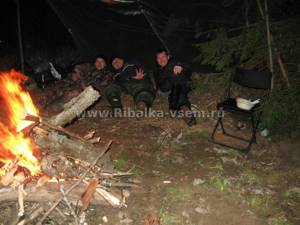
The conditions are already more comfortable, although, of course, there is also one very significant drawback - swarms of mosquitoes as fierce as wolves, more of them nagging and howling than biting. But this does not make them any closer. I would kill you, but you won’t kill everyone. And the current means of protection sometimes smell as if they were intended to disperse demonstrations, sometimes they corrode the skin, sometimes they squeak with pseudo-ultrasound, and their squeak attracts even more mosquitoes.
Catching pike with a spinning rod at night is not as common as fishing with a spinning rod for pike perch, which in the summer is mostly done on the rifts. However, there are times when nighttime pike fishing can be most effective.
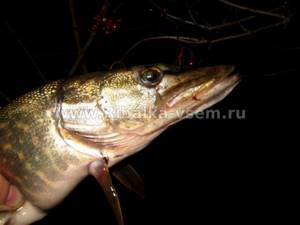
And such a period can confidently be called a time of long heat, the peak of which sometimes occurs in July, and sometimes in August, at least in its first half. As already mentioned, the predator at night is not so partial to the color of the bait, but is more focused on the sound and frequencies emitted by the spinner, the oscillating spoon. With twisters and other silicone baits the picture may be somewhat different. When jigging, there is also a knock on the bottom, simulating the fuss of a bottom fish.
Sometimes pike are caught at night on the riffles along with pike perch. But more often, its parking places are located behind the rifts, where the water swirls in the opposite direction. Probably every fisherman who spends the night by the river on a warm night has heard a fuss in the reeds and the slap of a tail on the calm water. It is after unbearably hot days on short July nights, when the water is like steam, that there is the best chance of effective pike fishing. During the day, pike simply have no time to eat. She is as hot and heavy as all living organisms, not counting, of course, the inhabitants of deserts.

The best place for night fishing for pike during this period may be a grassy riffle adjacent to a riverbed pit or with access to a pit. Often, the most catchy bait for such a place can be the most common oscillating spoon, which has high-frequency vibrations. But we must not forget the spinners. On a bright July night, the flickering of the pinwheel petal is visible even to an angler if the bait moves along the border of a sandy riffle and a grassy mane.
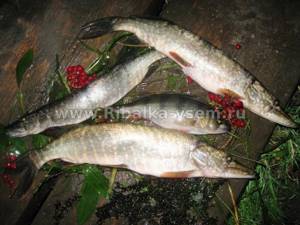
Night fishing for pike perch, as already mentioned, is often carried out next to pike fishing. Probably... well, what is probable, these predators definitely compete for the food supply, although they try not to coexist in their habitats. But their feeding exits inevitably coincide, since the best edges and riffles are not found very often, especially on a not very large river. It is on the endless reservoirs that they can disperse freely. The feeding time also coincides, when predators tired of the daytime heat can finally have a snack.
Fishing for pike with a spinning rod is completely different in some remote forest lakes, the bottom of which consists of soft peat silt. But among this soft peat cushion there are “patches” of sand. In some places these are really just small sandy areas on which reeds sway in the wind, and along the edges at a short distance whole fields of silt-sapropel begin again, and somewhere there are long stripes or spits, on the border of which it is no longer the water capsule that grows, but hornwort. Both of these characteristic places are a real paradise for predators, although the depth here is no more than one and a half to two meters. Of course, the species composition of such peat lakes is poor and often represents only two species - pike and perch, but fishing for these predators with a spinning rod at night can be quite successful. Sometimes it was surprising that, it would seem, in the dead period of the summer heat, there was often a periodic feeding of pike on summer fliers. It is generally accepted that pike catches best in spring and autumn during the golden “Indian summer”. But precisely because of the hot, sometimes unbearably hot days, the pike suddenly began to bite at night. This often coincided with the heat of July and the beginning of August. And then, on a bright night or just before dawn, the fliers of the girders began to unwind, the pine poles swayed and whipped their flexible tops over the warm water. The fished pike fought furiously, soaring above the water in its signature “candle.” This suggested that spinning rods could also be catchy gear. And so it turned out. Along the same edge of the hornwort at the border of the sand spit, pikes grabbed oscillating and rotating spoons, and not necessarily light ones, as would be logical for night fishing. But the live bait on such lakes was usually always dark, almost black perches living under the peat shores. Therefore, the color of the bait was not particularly important. If only it made noticeable oscillatory movements, perceptible to the pike in the dark water of the lake.
Catching pike with a spinning rod at night is not the only fishing on such lakes. During the same period, large seasoned humpback perch, often weighing more than two kilograms, become active. But he is more attracted to spinning light lures.
Fishing in such remote forest lakes is very mysterious. There are almost no fishermen here and therefore the forest life of the lake takes place in the lonely hum of pine forests, the rustle of reeds and the splash of waves. At night you can walk on the water in a boat, peering into the sleepy haze, looking for the girders, and very close by suddenly something stirs under the shallow water and the boat rocks on the waves, as if a motor boat was passing nearby. It’s clear that this is a predator, a pike, apparently of powerful stature. They wrote about such pikes in pre-war newspapers that they reached a weight of thirty kilograms, although the lake was shallow. But there have always been legends about the supposed second day under this lake, where these monsters still live.
In addition to oscillating and rotating spoons on forest lakes at night, you can quite successfully use dead perch fish on a rig. Moreover, it is not necessary to pull the perch along with you in a “path”, but you can make completely full-fledged spinning casts.
